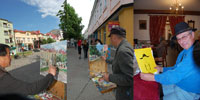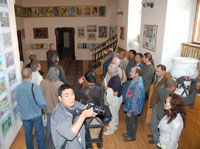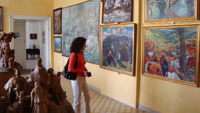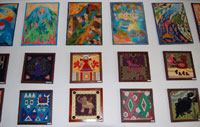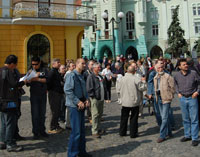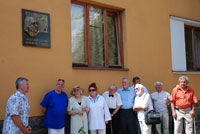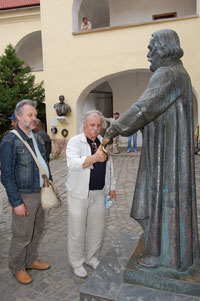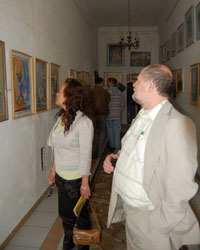The Way to Sensuality (History of plain-airs)
It is a nice tradition of professional artists to go into the nature, alone or in the company with fellow artists, and to work on plain-air far from the usual often obtrusive everyday rhythms, connections and civilization itself.
The Barbizons in France and the Pre-Raphaelites in England began to study the peculiarities of colour and the effects of light in the open air long before the impressionists. A lot of their paintings were painted right on the plain-airs which was almost a revolution in those days. According to the academic requirements a real painting was to be painted in a studio. But plain-air painting as a tendency becomes more evident with the rise of impressionists and their outrageous and innovative for that time search in painting (E. Manet, A. Renoir, E. Degas, C. Monet, C. Pissaro, A. Sisley, …). They bravely came out into the nature and tried to catch the uncatchable and to depict the undepictable – changes of light, trembling of the air in a hot or foggy day… They tried to reflect in the most natural way the surrounding world, its dynamism and changeability, the fleeting impressions of the simplest motifs. In the evenings they had hot discussions in Paris cafes, in Guerbois cafe in particular. Starting from that time artists resolutely go out of their studios in order to come back with a special prey – with plain-air studies, sketches or even finished paintings. They are less interested in using the cultivated for the centuries devices of work indoors. Besides, the tin tubes for colours appeared in 1840s. Now before going to plain air you don't have to mix the colours in advance and carry them in fragile glass bottles or bladders from animal entrails. The last were light but often leaky.
The traditional classically understandable and academically set conventionality of picturing life was not interesting any more, it seemed dead and with no prospect. And on the contrary, the plain-air painting dealing with the effects of air and light, has become something new and inspiratory. Painters have seen the world with new eyes, they have come to appreciate the flow of time, the changing play of light and shadows, and they have learnt to depict this flow and changeability. Due to plain-airs the abilities of painting language have become richer, and the sunlight, its twinkling was let into the space of canvas. There appeared the illusion of motion of figures painted in dynamics and certain positions, and also the presence of air, flowers, herbs…
During the last century and a half plain-airs have become not only the creative undertakings but have also gained the commercial character. Painters settle accounts not with fees and deductions from ordered works but with their paintings. This was not the practice in the former times. But such an archaic phenomenon as natural economy turned to be a tendency in artistic life and unexpectedly has favoured the development of the patron-artist attitudes in Ukraine. The following steps were logical: patrons were forming collections, organizing exhibitions, publishing catalogues, presenting paintings for the museums, planning another plain-airs and similar projects.
In the 21t century a plain-air painting in its habitual form – hiking with devices to "catch the motif", is not so actual though rather romantic. It was still in the 19th century that due to photography artists were freed from scrupulous depicting of people and things. Nature could be copied by means of photo. At the same time the creative photographers started looking for other possibilities than usual fixation. That is why a plain-air gains new aspects, new sense in the artistic life, it is being filled with another content and takes an important place as significant creative means in the life of art.
Communication of the artists is an important part of the work of creative groups. Often interesting ideas are being born in free discussions of the persons holding the same view. These ideas find their realization in different genres. For a certain time artists get rid of usual routine, they have arguments and produce ideas, they compete but also support one another.
"The portrait of the nature" is not the aim of the present plain-airs. Every artist can create the final product as something very individual. These can be installations or environments (ecological installations in the nature using the natural objects as parts of the project), photographs and video-films. But painting remains the tuning fork of all creative efforts.
It is worth mentioning that sculptors and photographers, and also writers and even scientists like to organize plain airs. They call them in a different way – symposiums, conferences and so on. So nowadays the creative work at plain-airs does not envisage the painting from the nature, though at the beginning this was the main achievement of the plain-air painters.
On July 17, 2009 the opening of the memorial plaque to Vasyl Habda (1925 – 2003), People’s Artist of Ukraine took place in Uzhhorod. The author of the plaque is sculptor Vasyl Roman.







